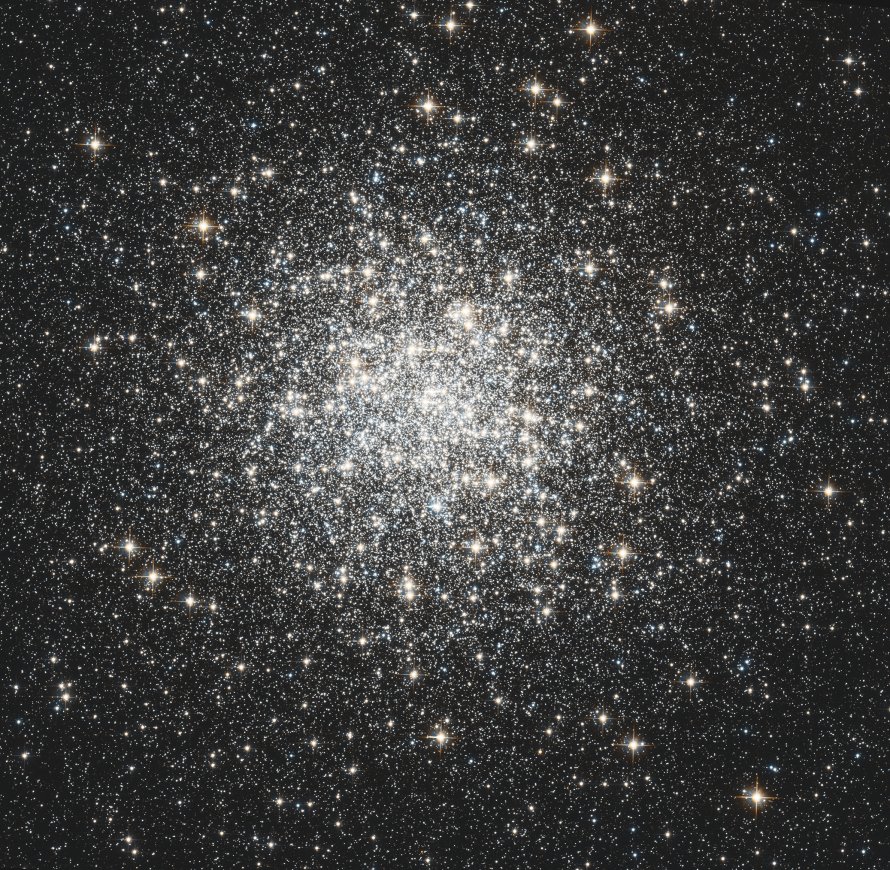M3 (NGC 5272)
Messier 3 (NGC 5272) is a globular cluster located in the constellation Canes Venatici, in the Galactic Center of the Milky Way Galaxy in the Local Group of galaxies. M3 is 34000 light years away from Earth.
M3 is best viewed during early spring, is magnitude 6.2, and can be viewed with binoculars. M3 is 18' in apparent size. For reference, the full moon is 30'.
Observing difficulty: Easy
- Name:
- Type:
- globular cluster
- Constellation:
- Canes Venatici
- NGC or IC:
- NGC 5272
- Magnitude:
- 6.2
- Viewing:
- binoculars
- Size:
- 18'
- Distance (light years):
- 34000 LY
- RA:
- 13h 42.2m
- Dec:
- 28 23'
- Season:
- early spring
- Milky Way location:
- Galactic Center
- Galaxy group:
- Local Group
- Messier Marathon #:
- 48
- Contains:
- 500,000 stars
* The naked eye can see up to magnitude ~7-8 objects under ideal dark sky conditions.
An Intimate Look into a Globular Cluster
Situated in the northern constellation of Canes Venatici, Messier 3, aka M3 or NGC 5272, stands as a brilliant cluster of over half a million stars bound together by gravity. One of the most substantial and stunning globular clusters, M3 is a well-studied celestial body that offers intriguing insights into stellar evolution and cosmological epochs. This article aims to provide a comprehensive and technical analysis of the majestic Messier 3.
Discovery and Observation
Messier 3 was discovered by the French astronomer Charles Messier on May 3, 1764. It was the first original discovery by Messier, who was better known for cataloging objects that could potentially be confused with comets
Physical Characteristics
M3 spans about 180 light-years in diameter, with a dense, concentrated core of about 6 light-years across. The tidal radius of M3, representing the outermost boundary of the cluster where stars can still be gravitationally bound, measures around 113 light-years. The average velocity of stars within M3 is approximately 10.4 km/s, indicating significant dynamical activity within the cluster.
Stellar Composition
M3 is home to an impressive 500,000 stars, providing a rich stellar ensemble for observation and analysis. The age of these stars is estimated to be around 11.4 billion years, thus belonging to the earliest generations of stars in the universe. Consequently, the stars of M3 are metal-poor, reflecting the primordial conditions of the universe. Stellar types include numerous red and yellow giants, along with a significant population of blue stragglers, whose existence is often attributed to stellar interactions or mergers within the dense cluster environment.
Structure and Formation
Globular clusters like M3 are thought to have formed during the early stages of the universe. The advanced age of their constituent stars, coupled with the spherical symmetry observed in these clusters, provides important clues about their formation. This spheroidal shape is a result of long-term gravitational interactions among the stars. Furthermore, tidal forces from the Milky Way itself also influence the structure and dynamics of M3.
Variable Stars and Other Phenomena
M3 is renowned for its exceptional abundance of variable stars. Over 274 variables have been identified in M3, the majority of which are RR Lyrae type variables. These stars have periods of pulsation that correlate closely with their intrinsic luminosities, making them valuable standard candles for distance measurement. In addition, M3 also hosts several dozen long-period variables and numerous short-period eclipsing binaries, providing ample opportunities for studying different stellar processes and interactions.
Scientific Significance
M3 continues to be a focal point for astrophysical research. The cluster's age, stellar composition, and dynamics provide valuable information on the conditions prevalent during the early universe and the subsequent evolution of galaxies. Additionally, M3's rich population of variable stars allows for precise distance measurements, thus playing a crucial role in calibrating cosmic distance scales. Its relatively close proximity to Earth further makes it an ideal object for detailed observational studies.
Apparent Magnitude and Distance
M3 has an apparent magnitude of 6.2, making it visible to the naked eye under extremely dark skies, but best seen with binoculars or a small telescope. Its actual distance from Earth is estimated to be about 33,900 light-years.
Finding and Observing Messier 3
M3 is located in the constellation Canes Venatici, but is actually easier to locate using the more noticeable constellation of Bootes, specifically by finding the star Arcturus and moving in a northwest direction. It can be viewed from both hemispheres but is most prominently visible from the Northern Hemisphere during the spring months.
Binoculars will reveal M3 as a faint, fuzzy object. With a small telescope, M3 appears as a beautiful, spherical cloud. Larger telescopes can resolve individual stars on the periphery of the cluster, with the dense core appearing increasingly well-defined and radiant. Observers should note that resolving the individual stars at the core can be challenging due to the density and mutual shielding of the stars.



